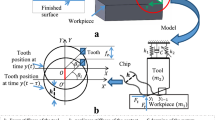Tubular hydroforming has recently attracted increased attention in the automotive industry and the finite-element analysis is an effective tool for evaluation and optimisation of the design of hydroforming dies and processes. In this paper, a comparison is made of an implicit and an explicit finite-element method, widely used for the hydroforming process. The influence of time scaling and mass scaling, which have been commonly used in order to save computational time, in an explicit method, for the hydroforming simulation of an automotive lower arm, are investigated. The comparisons focus on the accuracy of the predicted geometrical shape and the stress in the explicit method with various scaling factors.
Similar content being viewed by others
Author information
Authors and Affiliations
Rights and permissions
About this article
Cite this article
Choi, HH., Hwang, SM., Kang, Y. et al. Comparison of Implicit and Explicit Finite-Element Methods for the Hydroforming Process of an Automobile Lower Arm. Int J Adv Manuf Technol 20, 407–413 (2002). https://doi.org/10.1007/s001700200170
Issue Date:
DOI: https://doi.org/10.1007/s001700200170




